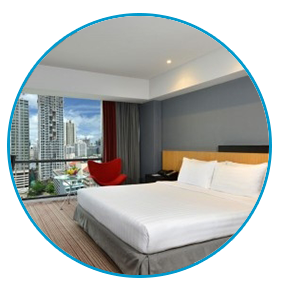ABOUT BANGKOK, THAILAND
source: www.tourismthailand.org
Bangkok Noi
A voyage through time
Bangkoks history is so closely connected to the waterways. It used to have so many canals that it was often called The Venice of The East. Rattanakosin Island came into existence when King Rama I had the Bang Lamphu Klong constructed to fortify Bangkok.
Cruising along the klongs as the canals are called in Thai, takes you on a journey of contrast back to earlier eras and up to modern Bangkok.
The most popular klong trips start on the Bangkok side of the Chao Phraya River and cross over to the Thonburi side to venture up Bangkok Noi and Bangkok Yai canals. These journeys take you to fascinating places such as The Royal Barge Museum and the colonial-style Thonburi Railway Station.
On the way you will see a different side of life as you pass the homes of the klong-dwellers. Each home seems to have its own boat, be it a small canoe or a hang yao the long-tailed boats powered by car or truck engines and a propeller on a long shaft that acts as both propulsion and steerage.
The contrast continues as you pass into idyllic rural pockets where villagers grow fruit, vegetables and orchids which are sent to markets on the long-tailed boats. Youll see children on there way to or from school and saffron robed monks travelling to their klong-side temples. You may even come across Thai women in boats selling boat noodles, drinks, snacks and fruit.
Most organized canal tours take you to a floating market at Taling Chan in Thonburi that operates from 8.30 a.m. until noon. It is usually crowded with other tourists.
How to get there: Tour boats depart from the pier beside the Oriental Hotel, at River City and Tha Chang Wang Luang Pier.
![]() Royal Barge National Museum
Royal Barge National Museum
The Royal Barge Procession is one of the most spectacular events in the world. It is performed occasionally during the Tod Kathin Buddhist Festival when H.M. The King delivers new robes to the monks at Wat Arun. It was also seen by millions of viewers around the world when it was specially staged for the 2003 APEC Conference in Bangkok and broadcast live to the participating countries.
These ornately decorated boats are maintained by the Royal Thai Navy and docked at The Royal Barge National Museum on Bangkok Noi canal on the Thonburi side.
The most impressive and important boat is the Kings personal barge, Suphanahong which was built in 1911. It is 46 metres in length hewn from a single tree and covered with intricate gilt carvings and colourful pieces of glass. The design is representative of a mythical swan. The crew consists of 54 oarsmen who paddle in time to the rhythmic beat of a drummer.
The Royal Barge fleet consists of 52 vessels. Each is a masterpiece of marine and traditional craftsmanship. They feature a variety of figureheads on their bows, including a sacred Garuda, Hanuman and the seven heads of Naga.
In formation the fleet travels in rows five abreast and more than one kilometer from the leading barge to those at the rear. These are propelled by 2,082 specially trained naval personnel
A visit to The Royal Barge National Museum will give you an insight into the colourful culture of Thailand.
How to get there: by Chao Phraya Ferry cross the river at Tha Pra Chan Pier near Thammasat University to Bangkok Noi (Thonburi) Train Station Pier or by chartered boat from Tha Chang Pier.
Open daily : 9 am. - 5 pm.
Admission : 30 baht
Tel : 0 2424 0004
www.thailandmuseum.com

![]() Wat Arun (Temple of Dawn)
Wat Arun (Temple of Dawn)
This famous Chao Phraya riverbank landmark diagonally opposite the Grand Palace, is best known for a porcelain encrusted 79 metre central pagoda which sparkles in the sun. The temple can be reached either by Arun Amarin Road or by boat from Tha Tian Pier near Wat Pho.
Open : Daily from 7.30 a.m. - 5.30 p.m.
Admission : 20 baht
Tel : 0 2465 5640




